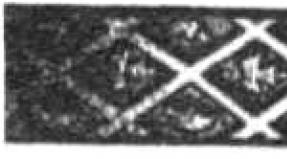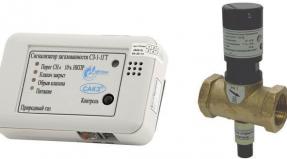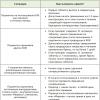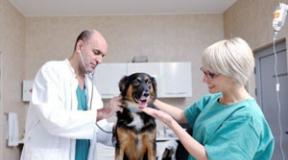Where it is possible and where it is impossible to work with HIV. Whom and how can people with HIV infection work? Rules for working with HIV-infected patients
In Russia, for the period up to 2020 and beyond, a state strategy has been approved to combat the spread of HIV infection. The situation with the incidence of HIV infections is disappointing. Since 2006, there has been an annual increase in the number of new HIV infections, an average of 10% per year. In 2015, 28.3 million citizens of the Russian Federation and about 2 million foreigners underwent a medical examination for HIV infection. In 2015, the number of HIV cases detected among foreign citizens doubled compared to 2013.
To date, the passage of a medical examination by the population to detect HIV infection is an insufficient measure to prevent the spread of this disease.
What is HIV infection and how is it transmitted? HIV is the human immunodeficiency virus. Immunodeficiency is a condition in which the body cannot resist various infections. Most HIV transmission occurs:
- with unprotected sexual intercourse;
- when the blood of an HIV-infected or AIDS patient enters the body of a healthy person (when transfusing blood or its products from HIV-infected donors; when using non-sterile, unprocessed medical instruments containing blood particles of infected people)
- from an HIV-infected or AIDS-infected mother to a child.
What law governs the procedure for preventing the spread of HIV infection? This is Federal Law No. 38-FZ of March 30, 1995 "On Preventing the Spread of Disease Caused by the Human Immunodeficiency Virus (HIV) in the Russian Federation." Medical personnel have the highest occupational risk of HIV infection. When working with patients, conducting laboratory studies of biomaterials, it is necessary to strictly comply with the requirements of labor protection. Medical staff should always remember the basic principle of epidemiological precaution: any patient is considered as a potential source of infection. At the workplace of a medical worker, it is necessary to have an ANTI-AIDS first aid kit. It is designed to prevent and prevent HIV infection. The recommended composition of the first aid kit includes disinfectants, treatment of wounds, cuts, material for dressings. It should be noted that the obligatory presence of such a first-aid kit is also expected in consumer service organizations. For example, in hairdressing and cosmetology centers (clause 9.30 SanPiN 2.1.2.2631-10).
Also, to prevent infection, personnel should use personal protective equipment - rubber gloves. In addition, antiseptic dispensers should be located in intensive care units (clause 12.8
HIV is not a sentence. Unfortunately, at the moment there is no cure for the human immunodeficiency virus, but modern medicine, thanks to antiretroviral therapy, allows those infected to lead a full life. This also applies to employment. The legislation of the Russian Federation regulates all legal aspects of HIV-infected people. However, stereotypes still exist, because of which many employers and employees do not want to see people with such a diagnosis in the ranks of their company. Now we will understand all the legal aspects of employment for HIV positive citizens.
Unfortunately, discrimination in employment is relatively common: too young or too old, the wrong sex, overweight or HIV. Is it legal to restrict an infected person from work? And are there professions that cannot be arranged by law? Let's answer right away - there are no restrictions for HIV positive. Federal Law 17 “On Preventing the Spread of Disease Caused by the Human Immunodeficiency Virus (HIV) in the Russian Federation” clearly states that an employer does not have the right to ask a person for confirmation of the absence of HIV or AIDS.
However, there is one exception here - if the future position is not included in a special list approved by the Government of “individual professions, industries, enterprises, institutions and organizations that undergo a mandatory medical examination to detect HIV infection during mandatory pre-entry work and periodic medical inspections." This list includes doctors, nurses, employees of transfusion and blood sampling stations, scientists whose work is directly related to the manufacture and development of immune drugs.
Often, when applying for a job in hotels, nurses, restaurants and other catering establishments, kindergartens, schools, universities, they also require an HIV test, explaining this by internal regulations. It is also illegal, since only the Government of the Russian Federation can approve the list of professions for which mandatory testing for the human immunodeficiency virus is required.
The only legitimate reason for being fired from your job is the fact that you are physically unable to perform your job duties. For such an action, a decision of the medical commission is necessary, specified in Article 81 of the Labor Code of the Russian Federation.
An HIV-positive person in the workplace or anywhere does not pose a danger to others, and discrimination against them on the basis of the disease is a complete violation of rights and freedoms. If you think that your rights are being violated, you are absolutely entitled to apply to the court and (or) to the federal labor inspectorate with an application for the restoration of violated rights, compensation for material damage and compensation for non-pecuniary damage. Remember, HIV is not a death sentence.
Is it possible for an HIV-positive employee to work as a cook in an educational institution? because Underage students and preschool children eat in our canteen.
What should an employer do if an employee has HIV?
Question
Is it possible for an HIV-positive employee to work as a cook in an educational institution? because Underage students and preschool children eat in our canteen.
Answer
Answer to the question:
By Decree of the Government of the Russian Federation of December 1, 2004 No. 715, the disease caused by the human immunodeficiency virus (HIV) is included in the list of socially significant diseases and in the list of diseases that pose a danger to others.
In accordance with Art. 5 of the Federal Law No. 38 dated March 30, 1995‑ Federal Law "On the prevention of the spread in the Russian Federation of a disease caused by the human immunodeficiency virus (HIV)" (hereinafter - Law No. 38‑ Federal Law) HIV-infected citizens of the Russian Federation have all rights and freedoms on its territory and bear obligations in accordance with the Constitution of the Russian Federation, the legislation of the Russian Federation and the legislation of the constituent entities of the Russian Federation.
The rights and freedoms of citizens of the Russian Federation may be restricted due to their HIV infection only by federal law.
In accordance with Art. 17 of Law No. 38‑ The Federal Law does not allow dismissal from work, denial of employment, denial of admission to educational institutions and institutions providing medical care, as well as restriction of other rights and legitimate interests of HIV-positive people on the basis of their HIV infection, as well as restriction rights and legitimate interests of family members of HIV-infected, unless otherwise provided by Law No. 38- FZ.
Thus, as a general rule, refusal to hire, dismissal from work only because a citizen (employee) has HIV infection is not allowed.
Meanwhile, the occupation of certain positions (professions) is incompatible with the presence of an HIV infection in an employee. Thus, employees of certain professions, industries, enterprises, institutions and organizations, the list of which is approved by the federal executive body authorized by the Government of the Russian Federation, are required to undergo a mandatory medical examination to detect HIV infection during mandatory pre-employment and periodic medical examinations. At present, such a list is approved by Decree of the Government of the Russian Federation of September 4, 1995 No. 877. In addition, Sanitary and Epidemiological Rules SP 3.1.5.2826‑ 10 the list of such professions has been clarified and supplemented. With this in mind, the following employees are subject to a mandatory medical examination to detect HIV infection upon admission to work and during periodic medical examinations:
Doctors, paramedical and junior medical staff of AIDS prevention and control centers, health care institutions, specialized departments and structural subdivisions of health care institutions engaged in direct examination, diagnosis, treatment, maintenance, as well as forensic medical examination and other work with infected persons human immunodeficiency virus, having direct contact with them;
Doctors, paramedical and junior medical personnel of laboratories (groups of laboratory personnel) who carry out examination of the population for HIV infection and examination of blood and biological materials obtained from persons infected with the human immunodeficiency virus;
Researchers, specialists, employees and workers of research institutions, enterprises (productions) for the manufacture of medical immunobiological preparations and other organizations whose work is related to materials containing human immunodeficiency virus;
Medical workers in hospitals (departments) of a surgical profile upon admission to work and in the future once a year;
Persons undergoing military service and entering military educational institutions and military service by conscription and contract, when called up for military service, when entering the service under a contract, when entering military universities of ministries and departments that establish restrictions on the recruitment of persons with HIV infection;
Foreign citizens and stateless persons when applying for a citizenship permit, or a residence permit, or a work permit in the Russian Federation, when foreign citizens enter the territory of the Russian Federation for a period of more than 3 months.
The list of specific positions and professions of employees (from among those indicated in the list) is determined by the head of the institution, enterprise, organization.
The educational institution is not indicated in this list, as well as catering workers. However, it is advisable to consult with an occupational pathologist who conducts examinations.
If, during the preliminary medical examination, a person applying for a position or profession provided for in the relevant lists is diagnosed with HIV infection, then the refusal to conclude an employment contract will be lawful. The refusal will also be lawful when an employee applying for a position (profession) whose occupation involves passing an examination to detect HIV infection refuses to undergo a medical examination.
If the employee refuses the mandatory medical examination, the employer is obliged to immediately remove him from work on the basis of Part 1 of Art. 76 of the Labor Code of the Russian Federation (hereinafter - the Labor Code of the Russian Federation) before passing the examination. During the period of suspension from work (non-admission to work), wages are not accrued to such an employee. Passing a periodic medical examination for these employees is an obligation, therefore, if an employee refuses to undergo a mandatory periodic medical examination (including for the detection of HIV infection) without good reason, he may be subject to disciplinary liability. This means that with an employee, under certain circumstances, an employment contract can be terminated under paragraph 5 of part 1 of Art. 81 of the Labor Code of the Russian Federation (for repeated non-fulfillment by an employee without good reason of labor duties, if he has a disciplinary sanction).
If HIV infection is detected in an employee holding a position provided for by the relevant list, he is subject to transfer (on a permanent basis) to another job available to the employer, excluding the conditions for the spread of HIV infection. In this case, the employee must give written consent to such a transfer. If the employee refuses to transfer or if the employer does not have the appropriate job, the employment contract with him is terminated in accordance with paragraph 8 of part 1 of Art. 77 of the Labor Code of the Russian Federation (refusal of an employee to transfer to another job, which is necessary for him in accordance with a medical report).
The need to transfer to another job in connection with the detection of HIV infection is not always associated with the occupation of a position (profession) provided for by a special list. Such a need may arise simply due to the fact that the disease leads to disability (the employee is unable to perform his/her work functions due to the development of the disease) up to the recognition of his disability. The medical and social expert commission in this case establishes the disability group, determines the measures of social protection and makes recommendations for further work. And if the employee refuses such a transfer or the employer does not refuse the relevant work, the employment contract with him is terminated in accordance with paragraph 8 of part 1 of Art. 77 of the Labor Code of the Russian Federation.
It is possible that, at a certain stage of illness, an employee may be recognized as completely incapable of working in accordance with a medical certificate issued in accordance with the procedure established by federal laws and other regulatory legal acts of the Russian Federation. In this case, the dismissal is carried out due to circumstances beyond the control of the parties - clause 5 of part 1 of Art. 83 of the Labor Code of the Russian Federation.
Details in the materials of the System Personnel:
Legal Framework
GOVERNMENT OF THE RUSSIAN FEDERATION
RESOLUTION
ON APPROVAL OF THE LIST OF EMPLOYEES OF INDIVIDUAL
PROFESSIONS, INDUSTRIES, ENTERPRISES, INSTITUTIONS
AND ORGANIZATIONS THAT PASS THE COMPULSORY MEDICAL
CERTIFICATION FOR THE DETECTION OF HIV INFECTION IN
CARRYING OUT MANDATORY PRELIMINARIES
EMPLOYMENT AND PERIODIC
MEDICAL EXAMINATIONS
In accordance with Article 9 of the Federal Law "On Preventing the Spread in the Russian Federation of a Disease Caused by the Human Immunodeficiency Virus (HIV)" (Sobraniye Zakonodatelstva Rossiyskoy Federatsii, 1995, No. 14, Art. 1212), the Government of the Russian Federation decides:
Approve the attached List of employees of certain professions, industries, enterprises, institutions and organizations that undergo a mandatory medical examination to detect HIV infection during mandatory pre-employment and periodic medical examinations.
Prime Minister
Russian Federation
V. CHERNOMYRDIN
Approved
Government Decree
Russian Federation
SCROLL
EMPLOYEES OF INDIVIDUAL PROFESSIONS, INDUSTRIES,
ENTERPRISES, INSTITUTIONS AND ORGANIZATIONS THAT ARE
MANDATORY MEDICAL CERTIFICATION FOR
DETECTION OF HIV INFECTION DURING COMPULSORY
PRELIMINARY ENTRY AND
PERIODIC MEDICAL EXAMINATIONS
1. The following employees are subject to mandatory medical examination to detect HIV infection upon admission to work and during periodic medical examinations:
a) doctors, paramedical and junior medical staff of centers for the prevention and control of AIDS, health care institutions, specialized departments and structural subdivisions of health care institutions engaged in direct examination, diagnosis, treatment, maintenance, as well as forensic medical examination and other work with persons infected with the human immunodeficiency virus, having direct contact with them;
b) doctors, paramedical and junior medical personnel of laboratories (groups of laboratory personnel) who carry out examination of the population for HIV infection and examination of blood and biological materials obtained from persons infected with the human immunodeficiency virus;
c) scientists, specialists, employees and workers of research institutions, enterprises (industries) for the manufacture of medical immunobiological preparations and other organizations whose work is related to materials containing human immunodeficiency virus.
2. The list of specific positions and professions of employees specified in paragraph 1 is determined by the head of the institution, enterprise, organization.
16073 0
In accordance with the Federal Law of March 30, 1995 No. 38-RF “On Preventing the Spread of Disease Caused by the Human Immunodeficiency Virus (HIV) in the Russian Federation” when providing medical care to HIV-infected people in order to prevent the spread of infection, reduce contacts to minimum, maintaining medical secrecy and targeted disinfection measures, it is advisable to place patients in separate rooms, providing for equipping these rooms with all necessary equipment. Isolation in towed compartments is necessary only if HIV-infected patients have bleeding, hemoptysis, open forms of tuberculosis. If it is impossible to isolate HIV-infected people in special departments, it is recommended to carry out all medical manipulations last, after the planned ones.
Symptoms of HIV infection in the oral cavity
To diagnose lesions of the oral mucosa in HIV-infected patients, a working classification was adopted, approved in London in September 1992. All lesions were divided into 3 groups.
1st group- Lesions clearly associated with HIV infection. This group includes the following nosological forms:
Candidiasis (erythematous, pseudomembranous, hyperplastic);
hairy leukoplakia;
marginal gingivitis;
ulcerative necrotic gingivitis;
destructive periodontitis;
Kaposi's sarcoma;
Non-Hodgkin's lymphoma.
2nd group Lesions less clearly associated with HIV infection:
bacterial infections;
diseases of the salivary glands;
viral infections;
thrombocytopenic purpura.
3rd group- lesions that may be with HIV infection, but not associated with it.
The lesions belonging to the 1st group are of the greatest interest and the most common.
candidiasis
Erythematous, or atrophic, is characterized by hyperemic areas of the mucosa without plaque with localization more often on the hard palate, back of the tongue and buccal mucosa. When localized on the tongue, atrophy of the papillae is noted.
Rice. Erythematous candidiasis
Pseudomembranous - the presence of whitish-yellowish removable plaques or plaque. Localization - any part of the mucous membrane.
Hyperplastic - plaque is tightly connected to the underlying tissue.
There are forms that combine the atrophic type with pseudomembranous.
Angular cheilitis - hyperemic lesions, cracks with erosion in the corners of the mouth. It is observed in the early and progressive stages of the disease, sometimes combined with xerostomia.
Hairy leukoplakia(VL) - occurs in 98% of those infected with HIV infection.
The cause is associated with the Epstein-Bar virus, but it has not been completely elucidated. According to clinical manifestations, VL looks like white folds or protrusions protruding above the surface, which resemble hair in shape. The predominant localization is the lateral and inferolateral surface of the tongue.
Sometimes manifestations of VL can be on the lip or floor of the mouth.
A characteristic feature of hairy leukoplakia is a dense attachment to the base and the absence of an inflammatory reaction, which is confirmed by histological studies. In most cases, the course of hairy leukoplakia is asymptomatic, so the examination of the oral cavity should be very thorough.

Rice. Hairy leukoplakia
Gingivitis occurs as a result of an exacerbation of a bacterial infection. Allocate marginal gingivitis, or the so-called marginal gingival erythema, which occurs acutely, suddenly. Signs of the disease may disappear after 3-4 weeks, but then exacerbations recur.

Rice. Gingivitis
Ulcerative-necrotic gingivitis is characterized by the progression of the process with ulceration and necrosis of the gingival papillae and marginal gums. Spontaneous bleeding is possible. This condition is noted in patients with high immune suppression.
Periodontitis characterized by rapid destruction of the alveolar bone and periodontal tissue, accompanied by pain and spontaneous gingival bleeding. Sometimes the presence of a sequester is detected. This condition is associated with profound immune suppression.
Viral infection in HIV-infected patients, it manifests itself in the form of viral papillomas and recurrent herpetic stomatitis.
Clinic: round or oval small multiple sharply painful sores appear. Localization - lips, hard or soft palate, cheeks. Ulcers may merge and form extensive bleeding ulcers covered with a yellowish pseudomembranous coating. Frequent recurrences and extensive confluent lesions appear in the late stages of HIV infection.
Kaposi's sarcoma- all cases were described with localization on the palate.
Clinical manifestations are characterized by the presence of spots of various colors - red, bluish, purple - and of varying intensity. Later, the spots darken, increase in size, and may ulcerate. Lesions are painful. When localized on the gum, it is necessary to differentiate with epulis. Oral manifestations may be the first signs of Kaposi's sarcoma. More common in homosexuals.

Rice. Kaposi's sarcoma
Non-Hodgkin's lymphoma- a lesion related to neoplasms may be in HIV-infected patients. Localization - hard palate and mucous membrane of the alveolar process.

Rice. Non-Hodgkin's lymphoma
Dental care for patients with HIV infection is provided in full in compliance with all safety measures. Medical personnel should be aware of the etiology, pathogenesis, treatment of HIV infection, as well as oral and systemic manifestations, laws, ethical standards, legal and psychological problems.
Safety rules for a nurse in a surgical dental office at the workplace
Wash hands before and after patient contact.
Treat blood and saliva as potentially infectious and only handle them with gloves.
Treat all biopsy materials as potentially infectious.
Consider all blood-stained linen, diapers, wipes as potentially infected.
If the integrity of the skin is broken, then before starting the manipulations, they should be covered with adhesive tape or smeared with BF glue.
Cleaning should be done with latex gloves.
When opening ampoules and carpules, giving syringes, cuts and injections should be avoided.
Do not reuse disposable instruments.
There should be various disposable containers with lids, containers with disinfectants for used syringes, needles, gloves, cotton-gauze material with clear markings on the working floors.
Until the end of the exposure in the disinfectant solution, it is forbidden to disassemble medical instruments.
Do not store infected material with blood and its components in open containers without disinfectants.
Do not put caps on used needles to avoid injury.
NB! The list of medicines included in the emergency first aid kit:
70% alcohol;
5% alcohol solution of iodine;
weighed portions of potassium permanganate, 50 mg;
1% boric acid solution;
distilled water 400 ml;
1% protargol;
bactericidal plaster;
dressings;
eye droppers;
sterile dressing material;
goggles, masks, gloves, thermometers;
tourniquet;
ammonia;
glasses, masks;
rubber gloves;
adinotimezide (AZT).
The first aid kit should be stored in an easily accessible place in a metal box.
Tactics of a surgical nurse in an emergency
In case of an injection or cut, wash your hands with soap and water under running water while wearing gloves, and then remove the gloves and immerse them in a disinfectant solution. Immediately squeeze out 2-3 drops of blood from the wound under running water, wash it under running water with soap, treat with 70% ethyl alcohol, and then, washing again with water, treat the wound with 5% iodine solution and seal with a plaster.
If blood or other biological fluids come into contact with the skin, to reduce the likelihood of infection, it is recommended to wash the skin areas with soap under running water, then treat this place with 70% ethyl alcohol (potassium permanganate solution 1:10,000 is used for treatment, for which you need to have a sample of the drug 50 mg, which is dissolved in 10 ml of distilled water).
In case of contact with biological fluids:
In the mouth - rinse your mouth and throat with 70% ethyl alcohol;
on the mucous membrane of the eye - rinse thoroughly with soap under running water and treat with a solution of boric acid or a 0.05% solution of potassium permanganate;
in the nose - drip 1% solution of protargol or 0.05% solution of potassium permanganate.
Immediately inform the administrator about the accident, involve an infectious disease specialist for a consultation, conduct a confidential examination of the victim with a mandatory examination for markers of viral hepatitis B and C, for HIV infection after 3, 4 and 12 months.
The proposed form of accounting for occupational injuries (abrasions, cuts, injections, contamination of mucous membranes with biomaterial):
Measures to ensure the professional safety of medical workers.
All injections and any manipulations with blood are carried out only in the treatment room in disposable gowns, gloves, masks, glasses specially provided for this purpose (if there is a threat of splashing blood, saliva).
In case of contamination of gloves, hands or exposed areas of the body with blood or saliva, they should be treated for 2 minutes with a swab abundantly moistened with an antiseptic (0.1% deoxone solution, 2% hydrogen peroxide solution in 70% alcohol, 70% alcohol), and through 5 minutes after treatment, wash with running water.
After use, needles and syringes are placed in a disinfectant solution without disassembly. After exposure, the syringe is washed with a piston, the needle is broken. Used syringes and gloves are thrown into a special container for disposal.
"Practical Guide to Surgical Dentistry"
A.V. Vyazmitina
Registration N 20263
In accordance with the Federal Law of March 30, 1999 N 52-FZ "On the sanitary and epidemiological well-being of the population" (Collected Legislation of the Russian Federation, 1999, N 14, article 1650; 2002, N 1 (part 1), article 2; 2003, N 2, item 167; N 27 (part 1), item 2700; 2004, N 35, item 3607; 2005, N 19, item 1752; 2006, N 1, item 10, N 52 (Part 1), Article 5498; 2007, N 1 (Part 1), Article 21; N 1 (Part 1), Article 29; N 27, Article 3213; N 46, Article 5554; No. 49, article 6070; 2008, No. 24, article 2801; No. 29 (part 1), article 3418; No. 30 (part 2), article 3616; No. 44, article 4984; No. 52 ( Part 1), Art. 6223; 2009, N 1, Art. 17; 2010, N 40, Art. 4969) and Decree of the Government of the Russian Federation of July 24, 2000 N 554 "On Approval of the Regulations on the State Sanitary and Epidemiological Service of the Russian Federation and Regulations on State Sanitary and Epidemiological Rationing" (Sobraniye Zakonodatelstva Rossiyskoy Federatsii, 2000, N 31, Art. 3295, 2004, N 8, Art. 663; N 47, Art. 4666; 2005, N 39, Art. 3953) I decide:
Approve the sanitary and epidemiological rules SP 3.1.5.2826-10 "Prevention of HIV infection" (Appendix).
G. Onishchenko
Appendix
Prevention of HIV infection
Sanitary and epidemiological rules SP 3.1.5.2826-10
I. Application area
1.1. These Sanitary and Epidemiological Rules (hereinafter referred to as the Sanitary Rules) establish the basic requirements for a set of organizational, therapeutic, prophylactic, sanitary and anti-epidemic measures, the implementation of which ensures the prevention of the emergence and spread of HIV infection.
1.2. Compliance with sanitary rules is mandatory for citizens, individual entrepreneurs and legal entities.
1.3. Control over the implementation of these sanitary and epidemiological rules is carried out by the bodies exercising state sanitary and epidemiological supervision.
III. General provisions
3.1. HIV infection is a disease caused by the human immunodeficiency virus - an anthroponotic infectious chronic disease characterized by a specific lesion of the immune system, leading to its slow destruction until the formation of acquired immunodeficiency syndrome (AIDS), accompanied by the development of opportunistic infections and secondary malignant neoplasms.
3.2. The diagnosis of HIV infection is established on the basis of epidemiological, clinical and laboratory data.
3.3. AIDS is a condition that develops against the background of HIV infection and is characterized by the appearance of one or more diseases classified as AIDS-indicative. AIDS is an epidemiological concept and is used for the purposes of epidemiological surveillance of HIV infection.
3.4. The causative agent of HIV infection, the human immunodeficiency virus, belongs to the lentivirus subfamily of the retrovirus family. There are two types of virus: HIV-1 and HIV-2.
3.5. The source of HIV infection is people infected with HIV at any stage of the disease, including during the incubation period.
3.6. Mechanism and transmission factors.
3.6.1. HIV infection can be transmitted through both natural and artificial transmission mechanisms.
3.6.2. The natural mechanism of HIV transmission includes:
3.6.2.1. Contact, which is realized mainly during sexual intercourse (both homo- and heterosexual) and upon contact of the mucous or wound surface with blood.
3.6.2.2. Vertical (infection of a child from an HIV-infected mother: during pregnancy, childbirth and breastfeeding.)
3.7.3. The artificial transmission mechanism includes:
3.7.3.1. Artifical in non-medical invasive procedures, including intravenous drug use (use of syringes, needles, other injection equipment and materials), tattooing, cosmetic, manicure and pedicure procedures with non-sterile instruments.
3.7.3.2. Artifical in invasive interventions in LPO. HIV infection can occur through transfusion of blood, its components, transplantation of organs and tissues, use of donor sperm, donor breast milk from an HIV-infected donor, as well as through medical instruments for parenteral interventions, medical devices contaminated with HIV and not processed in accordance with with the requirements of regulatory documents.
3.8. The main factors of pathogen transmission are human biological fluids (blood, blood components, semen, vaginal discharge, breast milk).
3.9. The main groups vulnerable to HIV infection are injection drug users (IDUs), commercial sex workers (CSWs), men who have sex with men (MSM). The high-risk group for HIV infection is represented by CSW clients, sexual partners of IDUs, prisoners, homeless children, persons with a large number of sexual partners, migrating population groups (truck drivers, seasonal workers, including foreign citizens working on a rotational basis and others), people who abuse alcohol and non-injecting drugs because they are more likely to engage in more risky sexual behavior when under the influence of psychoactive substances.
3.10. Clinical course of HIV infection without antiretroviral therapy.
3.10.1. Incubation period
The incubation period for HIV infection - this is the period from the moment of infection to the body's response to the introduction of the virus (the appearance of clinical symptoms or the production of antibodies) is usually 2-3 weeks, but can be delayed up to 3-8 months, sometimes up to 12 months. In this period, antibodies to HIV are not detected in an infected person, and therefore the risk of transmission of infection from him in nosocomial foci, including during transfusion of blood and its components, increases.
3.10.2. Acute HIV infection.
30-50% of those infected develop symptoms of acute HIV infection, which is accompanied by various manifestations: fever, lymphadenopathy, erythematous-maculopapular rash on the face, trunk, sometimes on the extremities, myalgia or arthralgia, diarrhea, headache, nausea and vomiting, liver enlargement and spleen, neurological symptoms. These symptoms appear against the background of a high viral load in different combinations and have varying degrees of severity. In rare cases, already at this stage, severe secondary diseases can develop, leading to the death of patients. In this period, the frequency of appeals of infected people to healthcare facilities increases; the risk of transmission of infection is high, due to the large amount of virus in the blood.
3.10.3. subclinical stage.
The duration of the subclinical stage averages 5-7 years (from 1 to 8 years, sometimes more), there are no clinical manifestations other than lymphadenopathy. At this stage, in the absence of manifestations, the infected person is a source of infection for a long time. During the subclinical period, HIV continues to multiply and the number of CD4 lymphocytes in the blood decreases.
3.10.4. Stage of secondary diseases.
Against the background of increasing immunodeficiency, secondary diseases (infectious and oncological) appear. Diseases of infections of a viral, bacterial, fungal nature at first proceed quite favorably and are stopped by conventional therapeutic agents. Initially, these are mainly lesions of the skin and mucous membranes, then organ and generalized lesions, leading to the death of the patient.
3.11. Antiretroviral therapy (APT) is an etiotropic therapy for HIV infection. At the present stage, APT does not completely eliminate HIV from the patient's body, but stops the reproduction of the virus, which leads to the restoration of immunity, the prevention of the development or regression of secondary diseases, the preservation or restoration of the patient's working capacity and the prevention of his death. Effective antiretroviral therapy is also a preventive measure that reduces the risk of the patient as a source of infection.
IV. Laboratory diagnosis of HIV infection
4.1. Laboratory diagnosis of HIV infection is based on the detection of antibodies to HIV and viral antigens, as well as, in special cases, the detection of HIV proviral DNA and HIV viral RNA (in children of the first year of life).
4.2. Laboratory studies for the diagnosis of HIV infection are carried out in institutions of the state, municipal or private healthcare system on the basis of a sanitary and epidemiological conclusion and a license provided in the manner established by the legislation of the Russian Federation.
4.3. The standard method for laboratory diagnosis of HIV infection is the determination of antibodies / antigens to HIV using ELISA. Confirmatory tests (immune, linear blot) are used to confirm HIV results.
4.4. Diagnostic algorithm for testing for the presence of antibodies to HIV:
4.4.1. At the first stage (screening laboratory).
If a positive result is obtained in the ELISA, the analysis is carried out consecutively 2 more times (with the same serum and in the same test system, the second serum is requested only if it is impossible to send the first serum for further testing). If two positive results are obtained out of three ELISA tests, the serum is considered primary positive and is sent to the reference laboratory (Laboratory for the diagnosis of HIV infection of the Center for the Prevention and Control of AIDS) for further research.
4.4.2. At the second stage (reference laboratory).
Primarily positive serum is re-examined in ELISA in a second test system from another manufacturer, which differs from the first one in the composition of antigens, antibodies or test format selected for confirmation. If a negative result is obtained, the serum is re-examined in a third test system from another manufacturer, which differs from the first and second ones in terms of antigen composition, antibodies, or test format. If a negative result is obtained (in the second and third test systems), a conclusion is issued on the absence of antibodies to HIV. Upon receipt of a positive result (in the second and / or third test system), the serum must be examined in an immune or linear blot. The results obtained in the confirmatory test are interpreted as positive, indeterminate and negative.
4.4.2.1. In order to ensure control and accounting of studies, reference diagnostics should be carried out in the same subject of the Russian Federation where the screening examination was carried out in the laboratory of an authorized specialized health care facility that carries out organizational and methodological work to carry out diagnostic, therapeutic, preventive and anti-epidemic measures for HIV infection and related diseases.
Reference diagnostics can also be carried out at the FGUN, on the basis of which the federal and district centers for the prevention and control of AIDS function, and at the FGU Republican Clinical Infectious Diseases Hospital (St. Petersburg).
4.4.3. Positive (positive) are samples that detect antibodies to 2 out of 3 HIV glycoproteins (env, gag, pol).
4.4.4. Sera are considered negative (negative) in which antibodies to none of the antigens (proteins) of HIV are detected or there is a weak reaction with the p18 protein.
4.4.5. Sera are considered indeterminate (doubtful) in which antibodies to one HIV glycoprotein and / or any HIV proteins are detected. When an indeterminate result is obtained with a protein profile that includes p25 core (gag) proteins, a test is performed to diagnose HIV-2.
4.4.6. Upon receipt of a negative and doubtful result in an immune or linear blot, it is recommended to examine the serum in a test system for the determination of p24 antigen or HIV DNA / RNA. If the p24 antigen or HIV DNA/RNA was detected, a second examination in the immune or linear blot is carried out 2, 4, 6 weeks after the first indeterminate result.
4.4.7. If an indeterminate result is obtained, repeated tests for antibodies to HIV by immune or linear blot are performed after 2 weeks, 3 and 6 months. If negative results are obtained in ELISA, then further research is not required. If, 6 months after the first examination, indeterminate results are again obtained, and the patient does not have risk factors for infection and clinical symptoms of HIV infection, the result is regarded as a false positive. (If there are epidemiological and clinical indications, serological studies are repeated as prescribed by the attending physician or epidemiologist).
4.5. Different approaches are used to diagnose HIV infection in children under 18 months of age born to HIV-infected mothers due to the presence of maternal antibodies.
4.5.1. To diagnose HIV infection in children under 12 months of age born to HIV-infected mothers, methods are used to identify HIV genetic material (DNA or RNA). A positive HIV DNA or HIV RNA test result in two separate blood samples from a baby older than one month of age is laboratory confirmation of HIV infection. Obtaining two negative test results for HIV DNA or HIV RNA at the age of 1-2 months and 4-6 months (in the absence of breastfeeding) testifies against the presence of HIV infection in the child, however, removing the child from the dispensary record due to intranatal and perinatal contact HIV infection can be produced at the age of over 1 year.
4.5.2. Deregistration for HIV infection at the age of 18 months is carried out with the simultaneous presence of:
Two or more negative test results for antibodies to HIV by ELISA;
The absence of severe hypogammaglobulinemia at the time of blood testing for antibodies to HIV;
Absence of clinical manifestations of HIV infection.
4.5.3. Diagnosis of HIV infection in children born to HIV-infected mothers who have reached the age of 18 months is carried out in the same way as in adults.
4.6. Laboratory diagnosis of HIV infection can only be carried out using certified standardized diagnostic test systems (kits) that are approved for use on the territory of the Russian Federation in accordance with the established procedure.
In order to conduct input quality control of the test systems used to detect persons infected with the human immunodeficiency virus, standard sera panels (industry standard samples) are used, which are approved for use in the prescribed manner.
4.7. The document issued by the laboratory based on the results of the study indicates the name of the test system, its expiration date, series, ELISA result (positive, negative), immune, linear blot result (list of detected proteins and conclusion: positive, negative, indefinite). In case of confidential examination, the document must contain passport data: full name, full date of birth, address of residence, contingent code. In an anonymous examination, the document is marked with a specially set code.
4.7.1. If a questionable result is obtained in a confirmatory test (immune, linear blot), a conclusion is issued about an indeterminate result of the study and it is recommended to repeat the examination of the patient until the status is determined (after 3.6, 12 months).
4.8. Simple/rapid HIV specific antibody tests are tests that can be performed without special equipment in less than 60 minutes. Blood, serum, blood plasma and saliva (scraping from the gum mucosa) can be used as the test material.
4.8.1. Application areas of simple/quick tests:
transplantology - before taking donor material;
donation - a blood test, in case of an emergency transfusion of blood products and the absence of donor blood tested for antibodies to HIV;
vertical prophylaxis - testing of pregnant women with unknown HIV status in the prenatal period (for prescribing drug prevention of HIV infection during childbirth);
post-exposure prophylaxis of HIV - testing for HIV in the event of an emergency.
4.8.2. Each study for HIV using simple/quick tests must be accompanied by a mandatory parallel study of the same portion of blood by classical methods of ELISA, IB.
4.9. The issuance of a conclusion on the presence or absence of HIV infection only on the basis of the results of a simple / rapid test is not allowed. The results of simple/quick tests are only used for timely decision making in emergency situations.
V. Procedure for testing for HIV infection
5.1. The main method for detecting HIV infection is testing for antibodies to HIV with mandatory pre- and post-test counselling. The presence of antibodies to HIV is proof of HIV infection. A negative HIV antibody test result does not always mean that a person is not infected because there is a "seronegative window" (the time between HIV infection and the appearance of antibodies, which is usually about 3 months).
5.2. Examination for HIV infection is carried out voluntarily, except in cases where such an examination is mandatory.
Mandatory medical examination for HIV infection is subject to:
Donors of blood, blood plasma, semen and other biological fluids, tissues and organs (including sperm), as well as pregnant women in case of sampling of abortive and placental blood for the production of biological preparations with each collection of donor material;
The following employees are subject to mandatory medical examination to detect HIV infection upon entry to work and during periodic medical examinations:
Doctors, paramedical and junior medical staff of AIDS prevention and control centers, health care institutions, specialized departments and structural subdivisions of health care institutions engaged in direct examination, diagnosis, treatment, maintenance, as well as forensic medical examination and other work with infected persons human immunodeficiency virus, having direct contact with them;
Doctors, paramedical and junior medical personnel of laboratories (groups of laboratory personnel) who carry out examination of the population for HIV infection and examination of blood and biological materials obtained from persons infected with the human immunodeficiency virus;
Researchers, specialists, employees and workers of research institutions, enterprises (production facilities) for the manufacture of medical immunobiological preparations and other organizations whose work is related to materials containing human immunodeficiency virus.
Medical workers in hospitals (departments) of a surgical profile upon admission to work and in the future once a year;
Persons undergoing military service and entering military educational institutions and military service by conscription and contract, when called up for military service, when entering the service under a contract, when entering military universities of ministries and departments that establish restrictions on the recruitment of persons with HIV infection;
Foreign citizens and stateless persons when applying for a citizenship permit or a residence permit, or a work permit in the Russian Federation, when foreign citizens enter the territory of the Russian Federation for a period of more than 3 months.
5.3. Voluntary HIV testing may be anonymous at the request of the examined person.
5.4. Health-care workers should recommend that individuals at higher risk of HIV infection receive regular HIV testing for early detection of HIV infection, HIV counseling and timely initiation of treatment if infected.
5.5. Examination for HIV infection (including anonymous) is carried out in medical institutions of all forms of ownership with the informed consent of the patient in conditions of strict confidentiality, and in the case of examination of minors under the age of 14 years - at the request or with the consent of his legal representative.
5.6. Examination for HIV infection is carried out with mandatory pre- and post-test counseling on HIV prevention.
5.7. Counseling should be carried out by a trained specialist (preferably an infectious disease doctor, epidemiologist or psychologist) and include the main provisions regarding HIV testing, the possible consequences of testing, determining the presence or absence of individual risk factors, assessing the knowledge of the examinee about HIV prevention, providing information about the ways of HIV transmission and ways of protection from HIV infection, types of assistance available for those infected with HIV.
5.8. When conducting pre-test counseling, it is necessary to fill out an informed consent form for an examination for HIV infection in two copies, one form is given to the examinee, the other is stored in the health facility.
5.9. A referral for a study in the enzyme immunoassay of a blood sample for HIV infection is filled in by all health care facilities, regardless of the legal form and form of ownership.
5.9.1. During confidential testing, personal data for a patient are given without abbreviations (according to a passport or a substitute document proving the identity of the subject): full name, full date of birth, citizenship, address of residence, contingent code.
5.9.2. For anonymous testing (without a passport), only a digital code is indicated, including the serial number of the person being examined, year of birth, place of residence (subject of the Russian Federation). Surname, name, patronymic of the person being examined is not indicated.
5.10. The answer about the result of the survey is issued at the end of the testing algorithm. The issuance of an official document on the presence or absence of HIV infection in the examined person is carried out only by institutions of the state or municipal health care system.
5.11. The results of the HIV test are reported to the examinee by the consultant during the post-test counseling; if possible, the same specialist conducts pre- and post-test counseling of the patient.
5.11.1. Counseling for any HIV test result should include a discussion of the significance of the result, taking into account the risk of HIV infection for the person being tested; explanation of the ways of HIV transmission and ways of protection from HIV infection for the examinee; types of care available for an HIV-infected person, and recommendations for further testing tactics.
5.11.1.1. Counseling for an indeterminate HIV test result, in addition to a set of standard information, should include a discussion of the possibility of HIV infection, the need to take precautions to prevent the spread of HIV infection, guarantees for the provision of medical care, treatment, and observance of the rights and freedoms of HIV-infected people. The person being tested is sent to the Center for the Prevention and Control of AIDS.
5.11.1.2. The person who is diagnosed with HIV infection is notified by the counselor of the test results. The specialist reports a positive test result in a clear and concise manner, provides time for the perception of this news, answers the questions of the subject. Explains the need for precautionary measures to prevent the spread of HIV infection, guarantees for the provision of medical care, treatment, respect for the rights and freedoms of HIV-infected people, as well as criminal liability for endangering or infecting another person. The person being tested is sent to the Center for the Prevention and Control of AIDS to be diagnosed with HIV infection, to provide medical care.
5.11.2. The results of the study are not reported over the phone.
5.11.3. The diagnosis of a disease caused by the human immunodeficiency virus is established by a doctor of the Center for the Prevention and Control of AIDS or an authorized doctor of a health care facility based on a set of epidemiological data, the results of a clinical examination and laboratory tests. The diagnosis of HIV infection is reported to the patient by a doctor (preferably an infectious disease doctor, epidemiologist or psychologist) in the course of counseling the patient at the Center for the Prevention and Control of AIDS or an authorized healthcare facility. The patient is notified in writing about the detection of HIV infection, and he is provided with information on this problem. If minors under the age of 18 are diagnosed with HIV, their parents or legal representatives are notified.
VI. Organization of dispensary observation of patients with HIV infection
6.1. The purpose of dispensary observation of HIV-infected patients is to increase the duration and maintain the quality of their life. The main objectives are to form adherence to dispensary observation, timely identification of indications for antiretroviral therapy, chemoprophylaxis and treatment of secondary diseases, provision of timely medical care, including psychological support and treatment of concomitant diseases.
6.2. HIV-infected persons are subject to invitations to primary and periodic examinations, but this should not violate their right to refuse examination and treatment, as well as the right to be observed in a medical institution of their own choice, expressed in writing.
6.3. Persons with an established diagnosis of HIV infection should be taken for dispensary observation for HIV infection. Dispensary supervision is carried out by a health care facility authorized by an administrative act of the health management body of a constituent entity of the Russian Federation.
Dispensary observation can also be carried out in FGUN, on the basis of which the federal and district centers for the prevention and control of AIDS function, and in the FGU Republican Clinical Infectious Diseases Hospital (St. Petersburg).
6.4. For each case of HIV infection (including when a positive result of a laboratory test for HIV infection of a sectional material is detected), an epidemiological investigation is carried out by specialists from the AIDS Center and, if necessary, by specialists from bodies exercising state epidemiological surveillance. Based on the results of the epidemiological investigation, a conclusion is made about the causes of the disease, sources of infection, leading routes and factors of transmission of HIV infection that caused the onset of diseases. Based on this conclusion, a set of preventive and anti-epidemic measures is being developed and implemented, including training of HIV-infected people and contact persons, prescribing specific and non-specific prophylaxis agents.
6.4.1. If nosocomial infection is suspected, an epidemiological investigation is carried out by specialists of the bodies exercising state epidemiological surveillance, together with specialists from the AIDS Centers and / or specialists from the Federal State Institution of Education, on the basis of which the federal and district centers for the prevention and control of AIDS function, the Federal State Institution Republican Clinical Infectious Diseases Hospital (Kazakhstan). Petersburg), with the involvement of the necessary experts.
For each case of nosocomial infection, a set of preventive and anti-epidemic measures is taken to localize the focus and prevent further spread of the infection, and an "Act of the epidemiological investigation" is drawn up.
6.4.2. An epidemiological investigation of sexual partners and drug-using partners is carried out using the “partner notification” method (if an HIV-infected person is found, contact persons are identified and they are given individual counseling on HIV prevention). An HIV-infected person is given the opportunity to either inform partners about the risk of HIV infection and invite them to counseling at the AIDS center, or provide the consultant with contact information about partners (usually the partner's name and phone number) for an invitation to counseling. The consultant must strictly follow the principle of anonymity of information and guarantee complete confidentiality to the first and all subsequent participants in the notification.
6.5. Dispensary supervision of children is carried out by the pediatrician of the AIDS Center together with the pediatrician of the LPO.
6.6. During the appointment, the doctor conducts a psychological adaptation of the patient, determines the completeness of the examination and treatment, evaluates and forms adherence to therapy.
6.7. Counseling on HIV infection is carried out at each examination of a patient with HIV infection as part of dispensary observation of him.
6.7.1. When observing HIV-infected children, counseling is provided to those who care for the child and those who are legally responsible for the child. Counseling of a child on HIV-infection is carried out in accordance with age characteristics.
6.8. During dispensary observation, counseling, scheduled examinations are carried out before the appointment of antiretroviral therapy, and during antiretroviral therapy, in accordance with existing standards, recommendations and protocols. It is necessary to ensure regular examination of HIV-infected people for tuberculosis (at least once every 6 months) and opportunistic infections, as well as the prevention of tuberculosis and pneumocystis pneumonia to all those in need in accordance with the requirements of regulatory documents.
6.9. Treatment of patients with HIV infection is carried out on a voluntary basis and includes the following areas: psychosocial adaptation of the patient, antiretroviral therapy, chemoprophylaxis of secondary diseases, treatment of secondary and concomitant diseases.
6.9.1. Antiretroviral therapy is an etiotropic therapy for HIV infection, it is carried out for life. Its appointment and control of efficiency and safety is carried out by the Center for the Prevention and Control of AIDS of the subject of the Russian Federation. This function can be performed by FGUN, on the basis of which the federal and district centers for the prevention and control of AIDS function; Federal State Institution Republican Clinical Infectious Diseases Hospital (St. Petersburg), as well as health care facilities under the methodological guidance of the AIDS Center.
6.9.2. To assess the efficacy and safety of APT, regular studies of viral load, CD4 lymphocyte count, clinical and biochemical blood tests, instrumental and clinical studies are carried out as part of dispensary observation. The main criterion for the effectiveness of APT is the reduction of viral load to an undetectable level.
6.9.3. Effective (with the achievement of an undetectable level of viral load) antiretroviral therapy is also a preventive measure that reduces the risk of the patient as a source of infection.
6.10. When identifying HIV-infected people who are on inpatient treatment, they should be provided with a consultation with an infectious disease specialist of the AIDS Center, laboratory tests necessary to clarify the stage of the disease and decide on the appointment of antiretroviral therapy.
6.11. In order to increase the effectiveness of dispensary observation and formation of adherence to antiretroviral therapy, a multiprofessional approach should be used involving the attending physician, nurse, medical specialists, psychologists, social workers, and trained consultants from among HIV-infected people. The formation of patients' adherence to dispensary observation is carried out on the basis of counseling technology within the framework of a patient-centered approach.
VII. State Sanitary and Epidemiological Surveillance of HIV Infection
7.1. Epidemiological surveillance of HIV infection is a system of constant dynamic and multidimensional monitoring of the dynamics and structure of the incidence (infection) of this infectious disease that occurs in the human population due to the peculiarity of the pathogenic agent (biological factor) that caused the infectious process, and various socio-demographic and behavioral characteristics of people.
7.2. The purpose of the state sanitary and epidemiological surveillance of HIV infection is to assess the epidemiological situation, trends in the development of the epidemic process; monitoring the coverage of the population with prevention, dispensary observation, treatment and support for HIV infection, the effectiveness of measures taken to make managerial decisions and the development of adequate sanitary and anti-epidemic (preventive) measures aimed at reducing the incidence of HIV infection; prevention of the formation of group diseases of HIV infection, severe forms and deaths.
7.3. State sanitary and epidemiological surveillance of HIV infection is carried out by bodies that carry out state sanitary and epidemiological surveillance.
7.4. Identification, accounting and registration of patients with HIV infection and HIV testing is carried out in accordance with established requirements.
7.4.1. Each case of HIV infection (positive immunoblot test result) is subject to registration and accounting at the place of detection in health care facilities, regardless of departmental affiliation and form of ownership. Registration at the place of residence of the patient is carried out for the organization of dispensary observation and treatment.
7.4.2. Information about a positive result of a blood test for HIV in immune blotting from the reference laboratory is transmitted to the screening laboratory and / or health facility that sent the material for the study, as well as to the territorial bodies exercising state sanitary and epidemiological supervision, the Federal Scientific and Methodological Center for Prevention and the fight against AIDS. When HIV infection is detected in nonresident residents of the Russian Federation, the information is transferred to the territorial center for the prevention and control of AIDS at the place of permanent registration of the patient.
7.4.3. Upon receipt of a positive test result for HIV in a blood donor, organs and tissues, information from the reference laboratory is transmitted within 24 hours by phone to blood service institutions (blood transfusion stations, blood transfusion departments) and to territorial bodies exercising state sanitary and epidemiological supervision .
7.4.4. An extraordinary report on each case of HIV infection in medical and preventive organizations or suspicion of it is transmitted to the bodies exercising state sanitary and epidemiological supervision in the subject of the Russian Federation, to the Federal body exercising sanitary and epidemiological supervision in the Russian Federation and the Federal Scientific and Methodological Center for Prevention and the fight against AIDS.
Upon completion of the epidemiological investigation, the Epidemiological Investigation Act is sent to the Federal Agency for Sanitary and Epidemiological Surveillance in the Russian Federation and the Federal Scientific and Methodological Center for the Prevention and Control of AIDS.
7.4.5. A healthcare facility that has changed or specified the diagnosis shall submit a secondary report on a patient with HIV infection to the Federal Scientific and Methodological Center for the Prevention and Control of AIDS and the Territorial Center for the Prevention and Control of AIDS at the place of permanent registration of the patient, indicating the amended (updated) diagnosis, date its establishment in the event of:
Establishing the causes of infection of an HIV-infected person,
Establishing a diagnosis of AIDS
Establishing the death of an HIV-infected or AIDS patient,
Change of the patient's place of residence,
Removal of the diagnosis of HIV infection,
Conclusions on the presence or absence of HIV infection in a child born to an HIV-infected mother.
7.5. Health care facilities that have laboratories conducting HIV research, regardless of organizational and legal forms, forms of ownership and departmental affiliation, including FGUN, on the basis of which the federal and district centers for the prevention and control of AIDS function, FGU "Republican Clinical Infectious Diseases Hospital" provide information on the results of a blood test for antibodies to HIV (monthly form N4 of the federal state statistical observation) to the center for the prevention and control of AIDS of the subject of the Russian Federation, on the territory of which HIV testing is carried out.
7.6. The bodies exercising sanitary and epidemiological supervision in the constituent entities of the Russian Federation, the health authorities of the constituent entities of the Russian Federation ensure monitoring and evaluating the effectiveness of measures for the prevention and treatment of HIV infection in the constituent entity of the Russian Federation in accordance with the approved indicators, and send the monitoring results to the Federal Authority, carrying out sanitary and epidemiological supervision in accordance with the established requirements.
7.7. Providing information about the diagnosis of HIV infection without the consent of a citizen or his legal representative is allowed in cases provided for by the legislation of the Russian Federation:
For the purpose of examination and treatment of a citizen who, due to his condition, is unable to express his will;
With the threat of the spread of infectious diseases, mass poisoning and lesions;
At the request of the bodies of inquiry and investigation, the prosecutor and the court in connection with the investigation or trial;
At the request of the military commissariats or the military medical service;
In the case of assistance to a minor under the age of 18 to inform his parents or legal representatives;
If there are grounds for believing that harm to the health of a citizen was caused as a result of unlawful actions.
With the written consent of a citizen or his legal representative, it is allowed to transfer information constituting a medical secret to other citizens, including officials, in the interests of examining and treating a patient, for conducting scientific research, publishing in scientific literature, using this information in the educational process and in other purposes.
VIII. Sanitary and anti-epidemic (preventive) measures for HIV infection
Prevention of HIV infection should be carried out in a comprehensive manner in relation to the sources of the virus, mechanisms, routes and factors of transmission, as well as the susceptible population, including those from vulnerable population groups.
8.1. Activities in epidemic foci of HIV infection
8.1.1. Measures taken in relation to the source of HIV infection
In relation to the identified source of HIV infection, measures are taken to reduce the likelihood of transmission of the virus:
8.1.1.1. Timely detection and diagnosis of HIV infection.
8.1.1.2. Specific antiretroviral therapy prescribed by a doctor (including preventive chemotherapy in pregnancy) reduces the viral load in an HIV-infected person and reduces the risk of HIV transmission.
8.1.1.3. Referral for testing and treatment of STIs infected with HIV reduces the risk of sexual transmission.
8.1.1.4. Referral of injecting drug users to drug dependence treatment reduces the activity of the source in transmitting the virus through drug use.
8.1.1.5. The ban on entry and deportation of HIV-infected foreign citizens in the manner prescribed by the legislation of the Russian Federation reduces the number of sources of infection in the country.
8.1.2. Actions on transmission mechanisms, pathways and factors
8.1.2.1. Disinfection and sterilization of medical instruments and equipment in medical institutions, as well as equipment and instruments in hairdressing salons, beauty salons, piercing and tattoo parlors, use of disposable instruments.
8.1.2.2. Ensuring and monitoring the safety of medical manipulation practices and the use of barrier methods of protection.
8.1.2.3. Examination of blood donors and any other donated materials for the presence of antibodies to HIV at each donation of donor material, quarantine of blood products and culling of infected donor material. Lifelong suspension of HIV-infected and positive in the ELISA in the reference study from donating blood, plasma, organs and tissues.
8.1.2.4. Conducting an epidemiological investigation of HIV infection.
8.1.2.5. Counseling/educating the population - both susceptible population and sources of infection - on safe or less dangerous behavior.
8.1.2.6. Preventive work with vulnerable population groups (IDUs, CSWs, MSM, etc.).
8.1.2.7. Prevention of the child's contact with the mother's body fluids should be combined with the prescription of ARV drugs and is achieved by:
During childbirth with a planned caesarean section in HIV-infected women;
After childbirth by replacing breastfeeding of the child of an HIV-infected mother with artificial.
8.1.2.8. At the request of an HIV-infected woman, she can be assisted in the prevention of unwanted pregnancies.
8.1.3. Measures for susceptible populations
8.1.3.1. Contact persons for HIV infection are considered to be persons who had the opportunity to become infected based on the known mechanisms, routes and factors of transmission of the infectious agent. Establishing the fullest possible circle of people who had contacts with an HIV-infected person makes it possible to inform about the methods and methods of protection against HIV infection during pre-test counseling and testing for HIV infection.
8.1.3.2. Teaching safe behavior in terms of HIV infection is the main measure for preventing HIV infection among contact persons and the population.
8.1.3.3. Carrying out preventive chemoprophylaxis. For emergency prevention of the disease, people at risk of contracting HIV infection are prescribed antiretroviral drugs, including: newborns of HIV-infected mothers, health workers and other exposure that puts you at risk of HIV infection.
8.2. Prevention of nosocomial HIV infection
8.2.1. The basis for the prevention of nosocomial HIV infection is the observance of the anti-epidemic regime in medical institutions in accordance with the established requirements (SANPIN 2.1.3.2630-10 "Sanitary and epidemiological requirements for organizations engaged in medical activities", registered with the Ministry of Justice of Russia on August 9, 2010. N18094). Preventive measures are carried out on the basis that each patient is regarded as a potential source of blood-borne infections (hepatitis B, C, HIV, and others).
8.2.2. Control and assessment of the state of the anti-epidemic regime in health care facilities is carried out by bodies exercising state sanitary and epidemiological supervision.
8.2.2.1. In order to prevent nosocomial transmission of HIV infection, it is necessary to ensure:
8.2.2.1.1. Compliance with the established requirements for disinfection, pre-sterilization cleaning, sterilization of medical devices, as well as for the collection, disinfection, temporary storage and transportation of medical waste generated in healthcare facilities.
8.2.2.1.2. Equipping with the necessary medical and sanitary equipment, modern atraumatic medical instruments, means of disinfection, sterilization and personal protection (special clothing, gloves, etc.) in accordance with regulatory and methodological documents. Single-use products after use in manipulations with patients are subject to disinfection / neutralization, their reuse is prohibited.
8.2.2.1.3. If a case of nosocomial HIV infection is suspected, a set of preventive and anti-epidemic measures is carried out in health care facilities:
8.2.2.1.4. An unscheduled sanitary and epidemiological investigation is carried out in order to identify the source, transmission factors, establish the circle of contact persons, both among staff and among patients who were in equal conditions, taking into account the risk of possible infection, and implement a set of preventive and anti-epidemic measures to prevent infection in conditions LPO.
8.3. Prevention of occupational HIV infection
In order to prevent occupational HIV infection, the following is carried out:
8.3.1. A set of measures to prevent accidents in the performance of various types of work.
8.3.2 Accounting for cases of injuries in the performance of professional duties, microtraumas by the personnel of healthcare facilities, other organizations, emergency situations with blood and biological fluids getting on the skin and mucous membranes.
8.3.3. In the event of an emergency at the workplace, a medical worker is obliged to immediately take a set of measures to prevent HIV infection.
8.3.3.1. Actions of a medical worker in an emergency:
In case of cuts and injections, immediately remove gloves, wash hands with soap and water under running water, treat hands with 70% alcohol, lubricate the wound with 5% alcohol solution of iodine;
If blood or other biological fluids get on the skin, this place is treated with 70% alcohol, washed with soap and water and re-treated with 70% alcohol;
If blood and other biological fluids of the patient come into contact with the mucous membrane of the eyes, nose and mouth: rinse the mouth with plenty of water and rinse with 70% ethyl alcohol, rinse the mucous membrane of the nose and eyes with plenty of water (do not rub);
If blood and other biological fluids of the patient get on the dressing gown, clothes: remove work clothes and immerse in a disinfectant solution or in a bix (tank) for autoclaving;
Start taking antiretroviral drugs as soon as possible for post-exposure prophylaxis of HIV infection.
8.3.3.2. It is necessary as soon as possible after contact to examine for HIV and viral hepatitis B and C a person who may be a potential source of infection and a person who has come into contact with him. An HIV examination of a potential source of HIV infection and a contact person is carried out by rapid testing for antibodies to HIV after an emergency with the obligatory sending of a sample from the same portion of blood for standard HIV testing in ELISA. Samples of plasma (or serum) of the blood of a person who is a potential source of infection, and a contact person, are transferred for storage for 12 months to an AIDS center of a constituent entity of the Russian Federation.
The victim and the person who may be a potential source of infection should be asked about the carriage of viral hepatitis, STIs, inflammatory diseases of the urogenital area, and other diseases, and counseling should be conducted regarding less risky behavior. If the source is infected with HIV, find out if he received antiretroviral therapy. If the victim is a woman, a pregnancy test should be done to see if she is breastfeeding. In the absence of clarifying data, post-exposure prophylaxis is started immediately, with the appearance of additional information, the scheme is adjusted.
8.3.3.3. Conducting post-exposure prophylaxis of HIV infection with antiretroviral drugs:
8.3.3.3.1. Antiretroviral drugs should be started within the first two hours after the accident, but no later than 72 hours.
8.3.3.3.2. The standard regimen for post-exposure prophylaxis of HIV infection is lopinavir/ritonavir + zidovudine/lamivudine. In the absence of these drugs, any other antiretroviral drugs can be used to start chemoprophylaxis; if a full HAART regimen cannot be started immediately, one or two available drugs are started. The use of nevirapine and abacavir is possible only in the absence of other drugs. If the only drug available is nevirapine, only one dose of the drug, 0.2 g, should be prescribed (it is not allowed to take it again), then when other drugs are received, full chemoprophylaxis is prescribed. If abacavir is started on chemoprophylaxis, testing for abacavir hypersensitivity reaction or switching from abacavir to another NRTI should be done as soon as possible.
8.3.3.3.3. Registration of an emergency is carried out in accordance with the established requirements:
LPO employees must immediately report each emergency to the head of the unit, his deputy or a higher manager;
Injuries received by health workers must be taken into account in each health care facility and acted as an accident at work with the preparation of an Act on an accident at work;
It is necessary to fill in the Journal of registration of accidents at work;
It is necessary to conduct an epidemiological investigation of the cause of the injury and establish a connection between the cause of the injury and the performance of the health worker's duties;
8.3.3.3.4. All health facilities should be provided with, or have access to, rapid HIV tests and antiretroviral drugs as needed. A stock of antiretroviral drugs should be stored in any health facility at the choice of the health authorities of the constituent entities of the Russian Federation, but in such a way that examination and treatment can be organized within 2 hours after the emergency. The authorized health facility should determine the specialist responsible for the storage of antiretroviral drugs, the place of their storage with access, including at night and on weekends.
8.4. Prevention of HIV infection during transfusion of donor blood and its components, organ and tissue transplantation and artificial insemination
8.4.1. Prevention of post-transfusion HIV infection, HIV infection during organ and tissue transplantation and artificial insemination includes measures to ensure safety when collecting, preparing, storing donated blood and its components, organs and tissues, as well as when using donor materials.
8.4.2. Preparation of donor blood and its components, organs and tissues.
8.4.2.1. Donors of blood, blood components, organs and tissues (including sperm) are allowed to take donor material after studying the documents and the results of a medical examination confirming the possibility of donation and its safety for medical use.
8.4.2.2. When carrying out activities to promote blood plasma donation, it is necessary to explain the need to re-examine the donor 6 months after donation.
8.4.2.3. The safety of donor blood, its components, donor organs and tissues is confirmed by the negative results of a laboratory study of donor blood samples taken during each collection of donor material for the presence of pathogens of bloodborne infections, including HIV, using immunological and molecular biological methods.
8.4.2.4. The selection of donor blood samples for the determination of markers of bloodborne infections is carried out during the procedure of donating blood and blood components directly from the system with blood (without violating the integrity of the system) or a special satellite container for samples included in this system into vacuum-containing (vacuum-forming) disposable test tubes corresponding to the applied research methods. When collecting organs and tissues (including sperm), the selection of blood samples from donors for the determination of markers of hemotransmissible infections is carried out in parallel with the procedure for collecting donor material (with each donation of donor material).
8.4.2.5. When examining a blood sample from a donor, the presence of antibodies to HIV-1, 2 and the HIV p24 antigen are simultaneously determined. The first immunological study (ELISA) is carried out in a single setting. Upon receipt of a positive result of the analysis, the corresponding study (ELISA) is repeated twice using the reagents used in the first setting. If at least one positive result is obtained during repeated testing for HIV markers, the donor material is disposed of, the sample is sent for a reference study.
8.4.2.6. It is forbidden to use test systems with lower sensitivity and specificity, as well as test systems or methods of a lower generation than those used in the initial analysis, for re-analysis of seropositive blood samples.
8.4.2.7. Molecular biological studies (PCR, NAT) are carried out in addition to mandatory immunological studies (ELISA) for markers of bloodborne infections in accordance with the requirements of regulatory documentation and are of auxiliary importance.
8.4.2.8. The first molecular biological study is carried out in a single setting. Upon receipt of a positive test result, the corresponding study is repeated twice using the reagents used in the first setting. If at least one positive result is obtained during repeated testing, the donor blood sample is recognized as positive, the donor material is disposed of.
8.4.2.9. Health care facilities that procure donated blood and its components are required to develop a system of good manufacturing practices that guarantee the quality, efficacy and safety of blood components, including the use of modern methods for detecting HIV-1, 2 and viral hepatitis markers and participation in an external quality control system.
8.4.2.10. Donor blood and its components are transferred to medical institutions for transfusion only after a repeated (at least 6 months later) examination of the donor for the presence of markers of HIV-1, 2 viruses and other bloodborne infections to exclude the possibility of not detecting infection during the seronegative window (quarantine) . Quarantine of fresh frozen plasma is carried out for a period of at least 180 days from the moment of freezing at a temperature below minus 25 C. After the quarantine period of fresh frozen plasma expires, a second examination of the donor's health and a laboratory test of the donor's blood are carried out in order to exclude the presence of pathogens of hemotransmissible infections in it.
8.4.2.11. Blood components with a short shelf life (up to 1 month) should be taken from staff (repeated) donors and used within the shelf life. Their safety should be additionally confirmed by PCR and other methods of NAT technology. In this case, blood plasma (serum) from the same and the next donation is used as the object of research.
8.4.2.12. As an additional measure that increases the viral safety of blood and its components, without replacing them, it is allowed to use methods of inactivation of pathogenic biological agents.
8.4.2.13. Non-safety or unused donated blood and blood components are isolated and disposed of, including disinfection with disinfectant solutions or the use of physical methods of disinfection using equipment authorized for this purpose in the established manner, as well as disposal of the resulting waste.
8.4.2.14. Data on donors of blood and its components, procedures and operations performed at the stages of procurement, processing, storage of donor blood and its components, as well as on the results of the study of donor blood and its components are recorded on paper and (or) electronic media. Registration data is kept for 30 years and must be subject to regulatory scrutiny.
8.4.3. When a blood donation organization receives information about a possible infection of a recipient with bloodborne infections, it is necessary to identify the donor (donors) from which infection could occur, and take measures to prevent the use of donated blood or its components obtained from this donor (donors).
8.4.3.1. If information is received about the possible infection of the recipient with bloodborne infections, an analysis of previous donation cases for a period of at least 12 months preceding the last donation is carried out, the documentation is reanalyzed, and the organization that processes the blood (plasma) evaluates the need to recall the manufactured blood products, taking into account type of disease, time interval between donation and blood test and product characteristics.
8.4.4. In the production of blood products, the safety of donor blood, in accordance with general principles, is confirmed by the negative results of laboratory testing of donor blood samples taken during each collection of donor material for the presence of pathogens of bloodborne infections, including HIV, using immunological and molecular biological methods.
8.4.4.1. Additionally, when processing plasma to obtain blood products, it is necessary to examine the plasma combined in the technological load for the presence of pathogens of bloodborne infections.
8.4.4.2. At all stages of production, measures should be provided to trace the donation of blood plasma included in the boiler load, production waste (disposable or transferred to other production facilities) and the finished medicinal product.
8.4.4.3. All plasma rejected during the input control for fractionation is subject to mandatory disposal.
8.4.5. Carrying out transfusions of donor blood and its components, transplantation of organs and tissues and artificial insemination.
8.4.5.1. It is prohibited to transfuse donor blood and its components, transplant organs and tissues and artificial insemination from donors who have not been examined for the presence of pathogens of bloodborne infections, including HIV, using immunological and molecular biological methods.
8.4.5.2. The physician prescribing transfusion of blood products should explain to the patient or his relatives the existence of a potential risk of transmission of viral infections, including HIV, during blood transfusion.
8.4.5.3. All manipulations for the introduction of blood transfusion media and blood products should be carried out in accordance with the instructions for use and other regulatory documents.
8.4.5.4. It is forbidden to administer blood transfusion media and preparations from human blood from one package to more than one patient.
8.4.6. In case of transfusion of donor blood, its components, transplantation of donor organs and tissues from an HIV-infected donor, immediately (but no later than 72 hours after transfusion/transplantation), it is necessary to carry out post-exposure chemoprophylaxis of HIV infection with antiretroviral drugs.
8.5. Prevention of vertical transmission of HIV infection
8.5.1. The detection of HIV infection in a pregnant woman is an indication for the prevention of mother-to-child transmission of HIV.
8.5.2. Infection of a child from an HIV-infected mother is possible during pregnancy, especially in the later stages (after 30 weeks), during childbirth and during breastfeeding.
8.5.3. The probability of HIV transmission from mother to child without preventive measures is 20-40%.
8.5.4. The use of preventive medical interventions can reduce the risk of infection of the child from the mother to 1-2%, even in the late stages of HIV infection.
8.5.5. The maximum effectiveness of preventive measures aimed at preventing the transmission of HIV infection from mother to child is achieved by reducing the viral load in the mother's blood to an undetectable level (during pregnancy and childbirth) and preventing contact of the child with the mother's biological fluids (during and after childbirth - blood, vaginal discharge, breast milk).
8.5.6. To reduce the amount of virus in the blood of a pregnant woman, it is necessary to conduct counseling and prescribe antiretroviral drugs.
8.5.7. In order to prevent contact of blood and other tissues of the mother and child, it is necessary:
8.5.7.1. Deliver if the mother has a viral load of more than 1,000 copies of HIV RNA/ml plasma, or if it is unknown, by a planned caesarean section: after reaching the 38th week of pregnancy, before the onset of labor and the outflow of amniotic fluid. In natural childbirth, reduce the anhydrous period to 4-6 hours.
8.5.7.2. Motivate an HIV-infected woman to refuse breastfeeding and attachment to the newborn.
8.5.8. Drug prevention of mother-to-child transmission of HIV infection (chemoprophylaxis) consists of prescribing antiretroviral drugs to mother and child. Antiretroviral drugs (ARVP) are prescribed to a woman from the 26-28th week of pregnancy (if the woman does not have indications for the appointment of permanent antiretroviral therapy), during childbirth and to the child after birth.
8.5.8. 1. Indications for the appointment of ARVP in a woman and a child:
The presence of HIV infection in a pregnant woman;
A positive result of testing for antibodies to HIV in a pregnant woman, including using rapid tests;
Epidemiological indications in a pregnant woman (if the result of the HIV test is negative and there is a risk of HIV infection in the last 12 weeks).
8.5.8.2. To prevent mother-to-child transmission of HIV during pregnancy and childbirth, a three-antiretroviral drug regimen is prescribed: 2 nucleoside reverse transcriptase inhibitors + 1 non-nucleoside reverse transcriptase inhibitor or 1 boosted protease inhibitor. In the process of chemoprophylaxis with antiretroviral drugs, a comprehensive monitoring of the effectiveness and safety of therapy is carried out according to the standard scheme.
8.5.8.3. Chemoprophylaxis is prescribed for all children of HIV-infected mothers from the first hours of life, but no later than 72 hours after birth or from the moment of the last breastfeeding (subject to its subsequent cancellation). The choice of an antiretroviral prophylaxis regimen for a child is determined by the completeness and quality of chemoprophylaxis in the mother during pregnancy, the regimen includes 1 or 3 drugs.
8.6. Prevention of HIV infection in public service organizations
8.6.1. Prevention of HIV infection in household service organizations (hairdressers, manicure, pedicure, beauty salons, offices, etc.), regardless of departmental affiliation and ownership, is provided in accordance with the requirements of SanPiN 2.1.2. 2631-10 "Sanitary and epidemiological requirements for the location, arrangement, equipment, maintenance and mode of operation of public utility organizations providing hairdressing and cosmetic services", registered by the Ministry of Justice of the Russian Federation on 07/06/2010, registration number 17694.
8.6.2. The organization and conduct of production control is assigned to the head of the organization.
IX. Hygienic education of the population
9.1. Hygienic education of the population is one of the main methods of HIV infection prevention. No single action alone can prevent or stop the HIV epidemic in the region. There should be a comprehensive, targeted program of prevention, treatment and care for various population groups.
9.2. Hygienic education of the population includes: providing the population with detailed information about HIV infection, measures for non-specific prevention of HIV infection, the main symptoms of the disease, the importance of timely detection of sick people, the need to take them to dispensary records and other activities using the media, leaflets, posters, bulletins, carrying out individual work aimed at shaping behavior that is less dangerous in relation to HIV infection.
9.3. Public education should include coverage of all approaches to safe and less dangerous behavior in terms of HIV infection: the safety of sexual behavior, the safety of parenteral interventions, occupational safety.
9.4. Preventive work among the population is carried out by bodies and institutions of Rospotrebnadzor in the constituent entities of the Russian Federation, health authorities and institutions, including: centers for the prevention and control of AIDS, narcological dispensaries and narcological rehabilitation centers, dermatological and venereal dispensaries, antenatal clinics and perinatal centers, centers medical prevention, health centers, employers, non-governmental and other organizations under the guidance of the AIDS Center.
9.5. HPEs, regardless of departmental subordination, should have in a place accessible to patients and visitors a visual campaign to prevent HIV infection, prevent drug use, information on the activities of medical institutions and public organizations that provide assistance to HIV-infected people who use psychoactive substances, people who provide sexual services for a fee, victims of violence, and helplines.
9.6. The curricula of educational institutions (municipal educational institutions, higher educational institutions, secondary specialized educational institutions, primary vocational training institutions, vocational schools) should include issues of HIV prevention.
9.7. It is necessary to ensure the implementation of HIV prevention programs in the workplace.
9.8. It is necessary to ensure the introduction of HIV prevention programs among population groups with a high risk of HIV infection (injecting drug users, men who have sex with men, commercial sex workers).
Read also...
- Maps of the Simbirsk province Old maps of the Simbirsk province by Schubert
- We clean coins at home: with soap, Coca-Cola, citric acid, electrolysis method
- Detailed map of the Oryol region with villages, cities, towns and districts Schubert's map of the Oryol province 1850
- What are the signs advised to do if you find a cross



















